Abstract
Aflatoxins have been a known cause of primary liver cancer in Mozambique since pre-independence epidemiological studies. However, their impact goes beyond public health, affecting the country’s economy and raising legal concerns. As a developing country endemic for Aspergillus, the nation has been struggling to keep up with external trade quality demands, delicate policy making, still dealing with the farmers’ limitations to control the contamination. The level and prevalence of aflatoxins show variations over time, geographic location, and across the different commodities. Considering the recommendations of the Codex Alimentarius, the major crops will be highly implicated unless there is major intervention from the authorities to control the toxins.
1. Introduction
Aflatoxins are not only a health and agricultural issue. They started as the cause for the loss of several turkeys in England [1,2], and were later the root of outbreaks of human aflatoxicosis in places such as India [3] and Kenya [4], and liver cancer in Mozambique [5]. However, the problem is far more complex, affecting trade and policymaking [6,7]. For example, limits for aflatoxin consumption have been actively discussed by the International Agency for Research on Cancer and Codex Alimentarius, among other organizations.
Mozambique has no specific legislation for aflatoxins [8], but the matter has already been discussed in academic and professional circles. These discussions were influenced by factors such as the pioneer realization of aflatoxin impact in the onset of primary liver cancer [5,9], rejection of peanuts by international buyers [7], and the casualties in Kenya [10].
This review aimed to provide a glance of how the aflatoxins are affecting the health, economy, and legal environment in Mozambique, and to provide some comments about it.
2. Impact
2.1. Risk Analysis
This analysis will be focused on the potential exposure to aflatoxins in Mozambique, based on the food, prevalence of contamination, and toxin levels, considering space and time. There is very little information on the demographic profile of who actually consumes the food or the safety measures, practices, or behaviors capable of affecting the exposure. A more accurate risk analysis would also require information on the quantity and frequency of intake for each food, and the Mozambican culture and habits are very heterogeneous, sometimes within the same region. For instance, Linsell and Peers [11] admitted their incapacity to assess the intake of a home-brewed beer made from cereals or groundnuts, “often taken irregularly as snacks”. Thus, this assessment is just a kick-start for future researchers willing to know more about the exposure of Mozambicans to aflatoxins.
The records show considerable variation in aflatoxin contamination among the samples analyzed throughout the years (p < 0.001) (Figure 1). It apparently declined since 1980, with the lowest level in 1999.
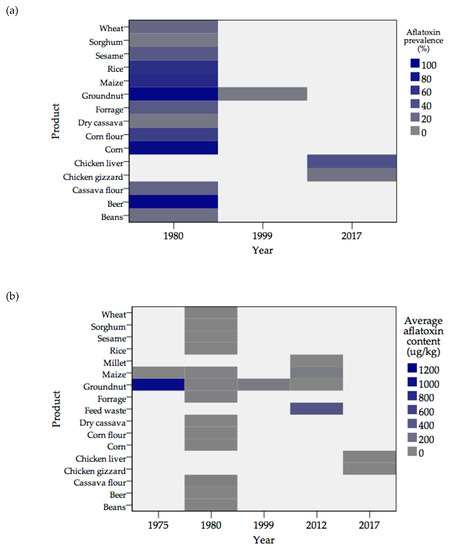
Figure 1.
Prevalence (a) and levels (b) of aflatoxins over time. Based on Casadei [12]; Van Rensburg, et al. [5]; van Wyk, et al. [7]; Warth, et al. [13]; and Sineque, et al. [8]. These studies were carried from 1985 to 2017 and included in total 934 samples including agricultural crops, chicken livers, and gizzards.
This could imply that the risk of contamination was highly reduced, but it is rising again. However, it is arguable because there was an overall change of the commodities analyzed, especially an increased focus on groundnuts and other products economically prioritized. It is hard to know if the risk of contamination is decreasing over time because there is a generalized effort to reduce food insecurity [14,15], at times not allowing the rejection of contaminated food [12], on one hand, and the dispersion seems to reflect the level of product variety. For example, groundnut was the sole product analyzed in 1999.
Regarding the aflatoxin levels, there were also notable variations in central tendency, though a Kruskal–Wallis test did not reveal significant differences among them (p = 0.478). This lack of difference was certainly due to the samples’ high level of dispersion, especially the ones from 1975. In any case, the central tendency was almost consistently (except in 2017) above the maximum limit recommended by the Codex Alimentarius (10 µg/kg). The highest record is from 1975, decreasing brusquely in the ensuing five years. Then, it grew until 2012 and then decreased again. Samples from 2017 are from chicken giblets, different from the crops directly contaminated in the field. Thus, direct analyses of groundnuts or maize will probably still show high levels of contamination.
Figure 2 displays the percentage of samples positive for aflatoxins regarding different commodities. Beer was surprisingly the most contaminated. This result conflicts with the perceived beer factories’ high quality standards. However, this information was obtained by Casadei [12] several years ago and it is likely to have changed because of international demands, as Mozambique exports beer. Corn and maize were among the most widely contaminated, as expected. However, groundnuts presented a considerably low prevalence if compared with other commodities. Perhaps its hard shell and other forms of resistance lead the fungus to produce high quantities of chemicals in order to invade.
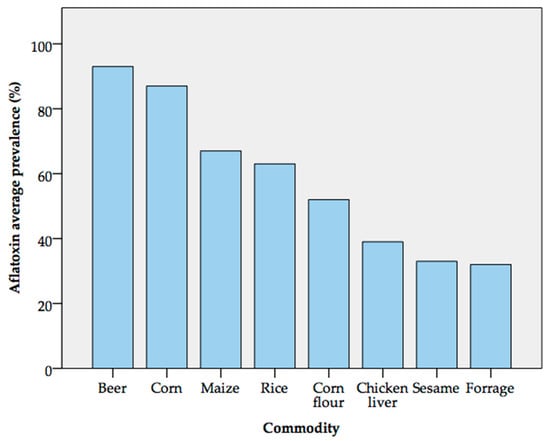
Figure 2.
Average aflatoxin prevalence among the samples. Based on Casadei [12]; Van Rensburg, et al. [5]; van Wyk, et al. [7]; Warth, et al. [13]; and Sineque, et al. [8]. These studies were carried from 1985 to 2017 and included in total 934 samples including agricultural crops, chicken livers, and gizzards.
The foods showed varying levels of contamination (Figure 3).
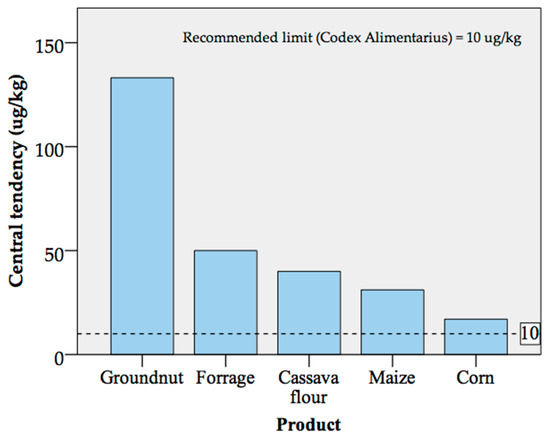
Figure 3.
Aflatoxin levels in different commodities. The Codex Alimentarius has set the reference limit for peanuts. It can be regarded as a good threshold to make a rough risk evaluation for food, probably not for feed. Feed waste was excluded from the graph because of its overwhelming value (443 μg/kg), outside the order of magnitude in relation to the other foods. Based on Casadei [12]; Van Rensburg, et al. [5]; van Wyk, et al. [7]; Warth, et al. [13]; and Sineque, et al. [8]. These studies were carried from 1985 to 2017 and included in total 934 samples including agricultural crops, chicken livers, and gizzards.
Feed waste was the most contaminated commodity, but it does not pose a direct threat to health, as there is no intention to use it as food or feed. There were six commodities above the limit recommended by the Codex Alimentarius Commission [16], while most foods did not seem to pose a significant threat to health.
2.2. Human and Animal Health
There is a wide literature on the impact of aflatoxins in human health. Thus, this review will refrain from echoing most of it, providing solely the little contribution from Mozambican aflatoxin research. Not much has been written since the studies in Inhambane over 40 years ago [9] and others related to them. Instead, several authors have been repeating their results, frequently neglecting the timeframe. Still, there are “side analyses” in a few animal studies giving a hint on how the toxins have been affecting the health in Mozambique.
Aflatoxins are a known component of primary liver cancer’s etiology [5,17], but they also affect children’s growth and livestock [18]. Sineque, et al. [8] tried to see the relationship between liver weight and aflatoxin B1 (AFB1) levels in chicken, but they did not seem correlated. However, Anjos, et al. [19] found signs of aflatoxin toxicity in chicks. According to them, it not only causes organ swelling but also growth retardation, liver lesions, reduction in serum proteins, and death.
The incidence of liver cancer can reach 40% in some African regions [20], and it is endemic in Mozambique, causing 65–70% of all cancer deaths in males and 30–55% in females [21]. However, it has a late-stage effect in the development of hepatocellular carcinoma, especially for people carrying hepatitis (HBV) [5].
Mozambique certainly faces the same challenges as any other tropical country with crops infested by aflatoxigenic Aspergillus. The country only needs to verify at what extent there are similarities or not between the local and international profiles, because there is plenty of information from all over the world. The methods are all developed and glimpses on what to expect are also available. It is now simply a matter of initiative.
2.3. Etiology
By now, it is clear that maize, cassava, and groundnuts are heavily contaminated with aflatoxins, in incidence, prevalence, and levels. This poses a problem because they are the main source of agricultural income to the country, and a staple food for the population [22].
Aflatoxins are particularly important for the peanut industry [18], and this is attributable to their potential to limit consumption by humans and livestock [23]. In Mozambique, groundnut is an important source of cooking oil [24]. Moreover, the country produces the highest volume of groundnuts in Southern Africa, mainly in Nampula and Cabo Delgado Provinces [7,25], and it is the most cultivated legume [26] locally. The high toxin content led South African importers to stop purchasing Mozambican groundnuts [7,17]. These international trade issues are happening all over Africa, especially because of the European Union’s demands [6]. From groundnuts only, Mozambique might lose up to US $4,000,000 in revenue [27].
Maize and cassava also require some attention. These commodities require quality certification for export, and the presence of aflatoxin is a strong barrier. Maize is the country’s most important staple food. Bandyopadhyay and Dubois [28] said that Mozambique produces 1.5 million tons per year, mostly in small farms for subsistence. Cassava raises even more concerns as it produces cyanogenic glycosides.
Anjos, et al. [19] said the most heavily infested grains are primarily sold for poultry feeding. This raises another issue with economic implications. Diverting the risk to animals might result in considerable losses. Indeed, that is exactly how AFB1 was discovered in first place [1,2]. However, the extent of such losses in Mozambique, or at least the risk, has yet to be investigated.
3. Resources
3.1. Facilities
Earlier analyses were frequently performed in foreign laboratories, but the local laboratories have been improving substantially. The capacity is expected to increase. The Directory of Calibration and Assay Laboratories in Mozambique [29] mentioned only two major institutions with the capacity for aflatoxin analyses:
- National Laboratory of Water and Food Hygiene (LNHAA);
- Directorate of Animal Sciences. The Mozambican Institute for Research on Agriculture (IIAM).
They are both in Maputo area and only LNHAA is indicated as accredited. Mondlane, et al. [30] used both laboratories to analyze poultry feed, and Sineque, et al. [8] used IIAM’s to study AFB1 in livers and gizzards. According to Baquete and Freire [31], LNHAA uses more TLC for aflatoxin analysis, but the laboratory also has HPLC. The other laboratory uses ELISA.
The International Institute for Tropical Agriculture (IITA) opened research facilities in the city of Nampula [32]. They include a laboratory where two Aspergillus bio-control products are prepared. They are thought to reduce the mold infestation of groundnut and maize fields and ultimately lower the aflatoxin levels to meet international commercial standards.
Harmsen, et al. [18] published a report describing a new laboratory for soil studies in the Tertiary Polytechnic Institute of Manica. It had no equipment for aflatoxin analysis, but they manifested the intention to include such gadgets in the project. They specifically mentioned HPLC, but the report admitted some alternatives.
3.2. Projects
The National Laboratory for Food and Water Hygiene (LNHAA) is arguably the best equipped in the country for aflatoxin screening projects. According to Casadei [12], this institution actively participated in major programs for quality control or the results and evaluation of analytic methods for aflatoxins. Some collaborators are AOAC (Association of Official Analytical Chemistry) and IARC (International Agency for Research on Cancer). We shall expect stronger alliances in this increasingly globalized world, with countries cooperating to face similar issues.
Baquete and Freire [31] told about a plan to be developed between LNHAA and the Faculty of Agriculture from Eduardo Mondlane University, called Groundnut Improvement Project, to develop practical guidelines from small farmers and traders. The current literature has no information on the follow up or if it was implemented, but the idea is constructive and would certainly make a difference. Yet, it probably has some connection with the bio-control project implemented by IITA in Nampula, because the university was also involved, and there is also intention to include an extension component.
The multi-toxin screening by Warth, et al. [13] in samples from Mozambique and Burkina Faso does not seem to involve major authorities from any of these countries. Instead, it took place in Nigeria in collaboration with the Austrian Development Agency. Yet, the project aims to introduce mycotoxin control technologies in Mozambique, Tanzania, and Burkina Faso. It is likely to include entities from these countries in the future.
3.3. Personnel
Food science is emerging in Mozambique, though subjects such as agriculture, biology, chemistry, and medicine have covered various related topics. The older generation of food scientists acquired their qualifications in different countries, and some of the newer are still doing the same. However, some tertiary institutions started licentiate and masters programs on food safety, technology, and nutrition [33,34,35].
Projects such as the IITA’s Aspergillus bio-control initiative can play a significant role in capacity building of national partners [28], and this can be a good kick-start to motivate young students to endeavor in aflatoxin research and mitigation.
4. Levels and Regulation
Many countries have distinct limits and changing trade patterns [36], and most are between 4 and 20 µg/kg for maize and peanuts [37]. African countries [37], including Mozambique [8], do not have adequately protective regulations for AFB1. Yet, the regulations from the developed countries impact the emerging economies, and their influence in the trade is increasingly unavoidable. For example, the European Union new Standard was about to reduce US $670 million in exports from African countries [38].
There is a law for Consumer’s Protection recently approved by the Government of Mozambique [39], but it lacks the depth to regulate mycotoxin contamination. Furthermore, Mozambique is a member of the Food and Agriculture Organization (FAO), World Health Organization (WHO), and the World Trade Organization (WTO). These organizations have been directing efforts to ensure the best feasible manufacturing and trade practices among their members.
A joint FAO/WHO Expert Committee on Food Additives (JECFA) established limits for aflatoxins through the Codex Alimentarius Commission [16]. The current limit for aflatoxin type B is 10 µg/kg, only for peanut and related nuts. It is still subject to some controversy because some developing countries advocate they should be higher while the European Union (EU) suggested a lower limit. Nevertheless, it is so far the best-agreed global threshold to evaluate the risk of exposure. It is possible to glance at the acceptability of some products from Mozambique considering the recommendation from the codex and the current information on the country’s aflatoxin levels.
Most food fell within the acceptable range, though sometimes the values over 10 µg/g were present in half of the samples (Figure 4). All samples from 2017 appeared to be within the acceptable range, but those were all from animal products, presumably low in aflatoxins. Ecologically, animals are consumers, and farm animals are usually primary consumers, if the feed is made from vegetables. Because the toxin reaches the livestock or poultry through feed, animal products are not expected to have the same aflatoxin levels as the plants. These results are alarming because the results from 1975 and 2012 are almost 40 years apart, but the situation remains, disregarding the most recent values. This is not encouraging for foreign companies willing to purchase commodities from Mozambique.
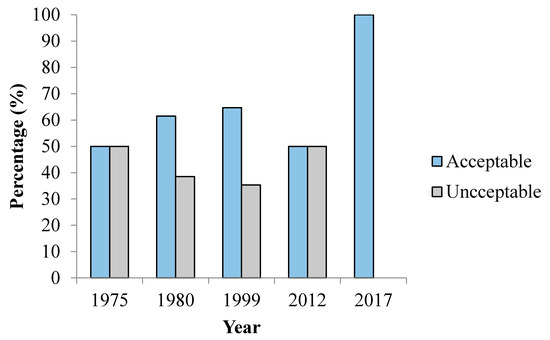
Figure 4.
Evaluation of the food analyzed over time based on the Codex Alimentarius limit. Based on Casadei [12]; Van Rensburg, et al. [5]; van Wyk, et al. [7]; Warth, et al. [13]; and Sineque, et al. [8]. These studies were carried out from 1985 to 2017 and included in total 934 samples including agricultural crops, chicken livers, and gizzards. The products per year can be seen in the Figure 1b.
Regarding the different districts, there were variations from 0% to 100% of acceptability (Table 1). In this case, the sample size probably influenced the results, as one can see bold divisions such as all, half, or one-third. Nevertheless, these values can provide a rough idea of where to direct the highest concerns.

Table 1.
Acceptability level of samples from different districts considering the Codex Alimentarius. Note: the overall value does not accurately reflect the ones on the table because it includes some data not specific for one or another district, but from several areas of Mozambique. Based on Casadei [12]; Van Rensburg, et al. [5]; van Wyk, et al. [7]; Warth, et al. [13]; and Sineque, et al. [8]. These studies were carried out from 1985 to 2017 and included in total 934 samples including agricultural crops, chicken livers, and gizzards.
Most samples (67.4%) are acceptable, but there are some cases of absolute unacceptability (Amendo and Muecate). Mugovula also had most samples with contamination above the limit (66.7%). Erati, Inhambane, Murrupula, Nacaroa (all 50%), and Nampula (40%) also require attention.
Just after harvest, most samples are above the limit (Figure 5). There is certainly selection of the less moldy specimens and it substantially improves the lot’s quality.
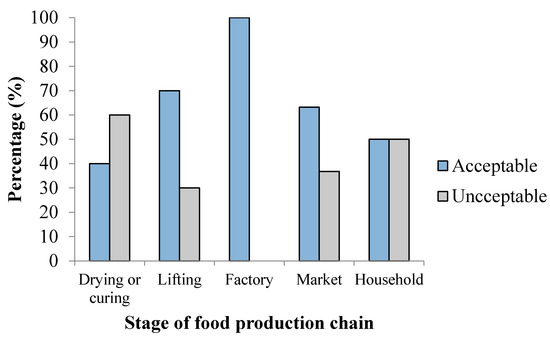
Figure 5.
Percentage of food acceptability through the chain of production considering the Codex Alimentarius. Based on Casadei [12]; Van Rensburg, et al. [5]; van Wyk, et al. [7]; Warth, et al. [13]; and Sineque, et al. [8]. These studies were carried out from 1985 to 2017 and included in total 934 samples including agricultural crops, chicken livers, and gizzards. The products per year can be seen in the Figure 1b.
There is an agreement that the level of contamination is not a linear function of the amount of mold infestation [40], but this logic might not apply to the field. The argument is based on the fact that even when the fungus is eliminated, the toxins remain in the commodity [41]. Such processes of elimination are post-harvest and there are cases in which the mold is actually there, and then it is removed. There is no reason why the fungi would parasite the commodity in the field and then abandon it without some sort of intervention. In such cases, infestation is more likely to be more tightly associated with contamination. From that moment on, the level of acceptability seems high to moderate. The peculiar result from the factory is that already discussed about animal products.
All samples but groundnut and maize were fully acceptable or unacceptable (Table 2). It is again probably an issue of sample size, leading to a higher standard error. Nonetheless, assuming it as the best lead available, most samples are within the recommended range, the unacceptable being cassava flour, corn, feed waste, and forage. The latter two of which are not an issue for human health because they are not foodstuffs. Groundnuts were mostly acceptable (60%), while maize was unacceptable (33.3%). The former appears to have relatively low heavily contaminated samples, while the latter has more of less contaminated specimens.

Table 2.
Codex acceptability regarding the commodities. Based on Casadei [12]; Van Rensburg, et al. [5]; van Wyk, et al. [7]; Warth, et al. [13]; and Sineque, et al. [8]. These studies were carried out from 1985 to 2017 and included in total 934 samples including agricultural crops, chicken livers, and gizzards.
In summary, many crops are fit for export if the Codex Alimentarius is enforced, but some require some attention if they are also to be internationally traded. The trend has never changed since the independence, and the area where the commodities are grown matters. Good agricultural practices can be of great help and simple procedures such as selection of non-infested grains can impact the final products. However, every step of the production chain, including the consumers’ behavior, is reflected in the fitness of the food to be consumed and acceptability considering the Codex Alimentarius.
5. Conclusions
Mozambique is among the countries most affected by AFB1, both in health and the economy, and this should be a cause for the country to lead in this line of research. There are currently more facilities than ever before, though screening studies require sophisticated and onerous material. Furthermore, there are alternatives to chemical analysis, probably more feasible, yet as relevant. Why not, for example, try to search for ways to control for known aflatoxigenic Aspergillus strains? Or just to analyze its growth pattern or how environmental factors affect the mold? Which other crops than groundnuts, maize, and cassava are being affected? Why not perform studies on economic losses? There is no need for much money in order to expand the knowledge about aflatoxin in Mozambique. Different sectors could try to study the best way to tackle this issue.
Funding
This research was funded by the Japanese Ministry of Education, Culture, Sports, Science, and Technology (MEXT) for the financial support.
Conflicts of Interest
The authors declare no conflict of interest.
References
- Stevens, A.; Saunders, C.; Spence, J.; Newham, A. Investigations into “diseases” of turkey poults. Vet. Rec. 1960, 72, 627–628. [Google Scholar]
- Van Der Zijden, A.S.M.; Koelensmid, W.A.A.B.; Boldingh, J.; Barrett, C.B.; Ord, W.O.; Philp, J. Aspergillus flavus and turkey X disease: Isolation in crystalline form of a toxin responsible for turkey X disease. Nature 1962, 195, 1060–1062. [Google Scholar] [CrossRef]
- Krishnamachari, K.; Nagarajan, V.; Bhat, R.; Tilak, T. Hepatitis due to aflatoxicosis: An outbreak in western india. Lancet 1975, 305, 1061–1063. [Google Scholar] [CrossRef]
- Lewis, L.; Onsongo, M.; Njapau, H.; Schurz-Rogers, H.; Luber, G.; Kieszak, S.; Nyamongo, J.; Backer, L.; Dahiye, A.M.; Misore, A. Aflatoxin contamination of commercial maize products during an outbreak of acute aflatoxicosis in eastern and central kenya. Environ. Health Perspect. 2005, 113, 1763–1767. [Google Scholar] [CrossRef] [PubMed]
- Van Rensburg, S.J.; Cook-Mozaffari, P.; Van Schalkwyk, D.J.; Van der Watt, J.J.; Vincent, T.J.; Purchase, I.F. Hepatocellular carcinoma and dietary aflatoxin in mozambique and transkei. Br. J. Cancer 1985, 51, 713–726. [Google Scholar] [CrossRef] [PubMed]
- SN. Redução de Perdas Pós-Colheitas: Moçambique Passa a Produzir Biocontrolos. Available online: http://www.jornalnoticias.co.mz/index.php/ciencia-e-ambiente/2466-reducao-de-perdas-pos-colheitas-mocambique-passa-a-produzir-biocontrolos.html (accessed on 20 May 2018).
- Van Wyk, P.; Van der Merwe, P.; Subrahmanyam, P.; Boughton, D. Aflatoxin contamination of groundnuts in mozambique. Int. Arachis Newsl. 1999, 19, 25–27. [Google Scholar]
- Sineque, A.R.; Macuamule, C.L.; Dos Anjos, F.R. Aflatoxin b1 contamination in chicken livers and gizzards from industrial and small abattoirs, measured by elisa technique in maputo, mozambique. Int. J. Environ. Res. Public Health 2017, 14, 951. [Google Scholar] [CrossRef] [PubMed]
- Van Rensburg, S.J.; Kirsipuu, A.; Coutinho, L.P.; Van Der Watt, J.J. Circumstances associated with the contamination of food by aflatoxin in a high primary liver cancer area. S. Afr. Med. J. 1975, 49, 877–883. [Google Scholar] [PubMed]
- Centers for Disease Control and Prevention. Outbreak of aflatoxin poisoning—Eastern and central provinces, Kenya, January–July 2004. MMWR. Morb. Mortal. Wkly. Rep. 2004, 53, 790–793. [Google Scholar]
- Linsell, C.A.; Peers, F.G. Aflatoxin and liver cell cancer. Trans. R. Soc. Trop. Med. Hyg. 1977, 71, 471–473. [Google Scholar] [CrossRef]
- Casadei, E. Os contaminantes nos alimentos. In Mocambique: Águas, Alimentos e Ambiente; Molisv: Rome, Italy, 1980. [Google Scholar]
- Warth, B.; Parich, A.; Atehnkeng, J.; Bandyopadhyay, R.; Schuhmacher, R.; Sulyok, M.; Krska, R. Quantitation of mycotoxins in food and feed from burkina faso and mozambique using a modern lc-ms/ms multitoxin method. J. Agric. Food Chem. 2012, 60, 9352–9363. [Google Scholar] [CrossRef] [PubMed]
- Griggs, D.; Stafford-Smith, M.; Gaffney, O.; Rockström, J.; Öhman, M.C.; Shyamsundar, P.; Steffen, W.; Glaser, G.; Kanie, N.; Noble, I. Policy: Sustainable development goals for people and planet. Nature 2013, 495, 305–307. [Google Scholar] [CrossRef] [PubMed]
- Cabinet Council. Plano de Acção para a Redução da Pobreza Absoluta; Conselho de Ministros: Maputo, Mozambique, 2006. [Google Scholar]
- Codex Alimentarius Commission. Codex General Standard for Contaminants and Toxins in Food and Feed; Codex stan 193-1995; Codex Alimentarius Commission: Washington, DC, USA, 2013. [Google Scholar]
- Augusto, J.; Atehnkeng, J.; Akello, J.; Cotty, P.; Bandyopadhyay, R. Prevalence and distribution of aspergillus section flavi in maize and groundnut fields and aflatoxin contamination in mozambique. In 2014 APS-CPS Joint Meeting; The American Phytopathological Society: Minneapolis, MN, USA, 2014. [Google Scholar]
- Harmsen, J.; Bremmer, J.; Maria, R.M. Pre Evaluation of a Soil and Plant Laboratory in Mozambique; Alterra: Wageningen, The Netherlands, 2012; p. 60. [Google Scholar]
- Anjos, F.D.; Ledoux, D.; Rottinghaus, G.; Chimonyo, M. Efficacy of mozambican bentonite and diatomaceous earth in reducing the toxic effects of aflatoxins in chicks. World Mycotoxin J. 2016, 9, 63–72. [Google Scholar] [CrossRef]
- PACA. What Is the Aflatoxin Problem? Available online: http://aflatoxinpartnership.org/?q=node/413 (accessed on 2 May 2018).
- Ozturk, M. P53 mutation in hepatocellular carcinoma after aflatoxin exposure. Lancet 1991, 338, 1356–1359. [Google Scholar] [PubMed]
- Muitia, A. Farmer Perceptions and Genetic Studies of Rosette Disease in Groundnut (Arachis hypogaea L.) in Northern Mozambique. Ph.D. Thesis, University of KwaZulu-Natal, Pietermaritzburg, South Africa, 2011. [Google Scholar]
- Rahmianna, A.; Taufiq, A.; Yusnawan, E. Effect of harvest timing and postharvest storage conditions on aflatoxin contamination in groundnuts harvested from the wonogiri regency in indonesia. ICRISAT 2007, 5, 1–3. [Google Scholar]
- Muitia, A.M. Combination of Root-Knot Nematode (Meloidogyne spp.) Resistance and Edible Seed Quality for Peanut (Arachis hypogaea L.) Production in Mozambique and in the US. Ph.D. Thesis, Texas Tech University, Lubbock, TX, USA, 2005. [Google Scholar]
- Zuza, E.; Mondjana, A.; Muitia, A.; Amane, M. Effects of harvesting date on aflatoxin contamination in groundnuts in northern mozambique. In The Fifth RUFORUM Biennial Conference and African Higher Education Week; Nampala, M.P., Egeru, A., Tusiime, G., Osiru, M., Mensah, S., Adipala, E., Eds.; Regional Universities Forum for Capacity Building in Agriculture (RUFORUM): Cape Town, South Africa, 2016; Volume 14, pp. 167–172. [Google Scholar]
- Arias, F.J.; Libombo, M. Groundnut Evaluation in Mozambique: Preliminary Results for the 1993/94 Season in Maputo Province; Ndunguru, B.J., Hildebrand, G.L., Subrahmanyam, P., Eds.; Sustainable Groundnut Production in Southern and Eastern Africa, Mbabane, 1994; International Crops Research Institute for the Semi-Arid Tropics: Mbabane, Swaziland, 1994. [Google Scholar]
- Walker, T.; Pitoro, R.; Tomo, A.; Sitoe, I.; Salência, C.; Mahanzule, R.; Donovan, C.; Mazuze, F. Priority Setting for Public-Sector Agricultural Research in Mozambique with the National Agricultural Survey Data; Directorate of Training, Documentation, and Technology Transfer, Institute of Agricultural Research of Mozambique: Maputo, Mozambique, 2006; p. 80. [Google Scholar]
- Bandyopadhyay, R.; Dubois, T. Aflatoxin control projects launched in Southern Africa. IIAPPS Newsl. 2012, 2, 2–4. [Google Scholar]
- ALM. Directório dos Laboratórios de Calibração e de Ensaios em Moçambique; Associação de Laboratórios de Moçambique: Vienna, Austria, 2013; p. 69. [Google Scholar]
- Mondlane, I.A.P.; Capece, B.P.S.; Parruque, A.F. Relação entre a Ocorrência de Fungos e a Presença de Aflatoxinas b1 em Rações para Aves Fabricadas em Maputo; Instituto de Investigação Agrária de Moçambique: Maputo, Mozambique, 2005. [Google Scholar]
- Baquete, E.; Freire, M. Present status and perspectives of aflatoxin research in mozambique. Aflatoxin Contam. Groundn. 1989, 93–94. Available online: http://oar.icrisat.org/502/1/RA_00132.pdf#page=263 (accessed on 10 May 2005).
- U.S. Embassy Maputo. Inauguration of Iita’s New Facilities in the Celebration of Its 50th Year Anniversary. Available online: https://mz.usembassy.gov/inauguration-iitas-new-facilities-celebration-50th-year-anniversary/ (accessed on 10 May 2018).
- UCM. Licenciatura em Engenharia Alimentar. Available online: http://www.ucm.ac.mz/cms/node/254 (accessed on 3 May 2018).
- UEM. Uem Introduz Licenciatura em Tecnologia de Alimentos. Available online: http://www.uem.mz/index.php/noticias-recentes/380-uem-introduz-licenciatura-em-tecnologia-de-alimentos (accessed on 3 May 2018).
- ISPG. Plano Curricular do Curso de Licenciatura em Engenharia de Processamento de Alimentos; Instituto Superior Politécnico de Gaza: Lionde, Mozambique, 2016. [Google Scholar]
- Wu, F.; Guclu, H. Aflatoxin regulations in a network of global maize trade. PLoS ONE 2012, 7, e45151. [Google Scholar] [CrossRef] [PubMed]
- Wu, F.; Stacy, S.L.; Kensler, T.W. Global risk assessment of aflatoxins in maize and peanuts: Are regulatory standards adequately protective? Toxicol. Sci. 2013, 135, 251–259. [Google Scholar] [CrossRef] [PubMed]
- Akrobortu, D.E. Aflatoxin Contamination of Maize from Different Storage Locations in Ghana. Ph.D. Thesis, Kwame Nkrumah University of Science and Technology, Accra, Ghana, 2008. [Google Scholar]
- Government of Mozambique. Regulamento da lei de Defesa do Consumidor; In 7; Assembleia da República, Ed.; Imprensa Nacional de Moçambique: Maputo, Mozambique, 2016; Volume 27, pp. 505–510.
- Carlson, M.P.; Ensley, S.M. Sampling and Analyzing Feed for Fungal (Mold) Toxins (Mycotoxins); Cooperative Extension, Institute of Agriculture and Natural Resources, University of Nebraska-Lincoln: Lincoln, NE, USA, 2003. [Google Scholar]
- Di Stefano, V.; Pitonzo, R.; Cicero, N.; D’Oca, M.C. Mycotoxin contamination of animal feedingstuff: Detoxification by gamma-irradiation and reduction of aflatoxins and ochratoxin a concentrations. Food Addit. Contam. Part A Chem. Anal. Control Expo. Risk Assess. 2014, 31, 2034–2039. [Google Scholar] [CrossRef] [PubMed]
© 2018 by the authors. Licensee MDPI, Basel, Switzerland. This article is an open access article distributed under the terms and conditions of the Creative Commons Attribution (CC BY) license (http://creativecommons.org/licenses/by/4.0/).